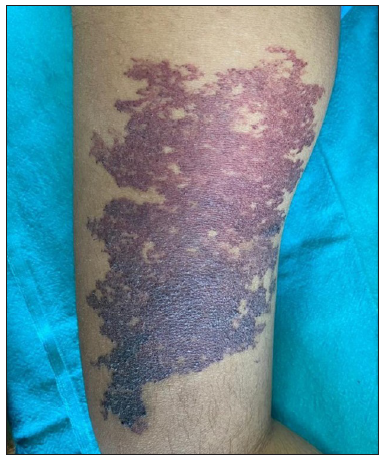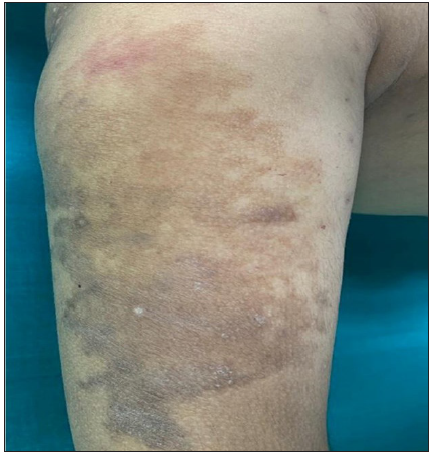Capillary malformations are successfully treated with pulse dye laser (PDL) But as it is very expensive, most dermatology clinics/ institutes don’t have it. PDL is out of reach for patients due to high cost per session and multiple sessions are generally required to treat vascular lesions. As a result, majority of the patients have to spend rest of their lives coping with psychological stress and cosmetic anxiety.
SolutionTo overcome this difficulty, we used a 3% polidocanol foam formulation as a sclerosing agent for the treatment of capillary malformation [Figure 1]. Polidocanol (synthetic detergent-like substance) disrupts endothelial vessels, causing clotting and inflammation, resulting in closure. It is efficacious, safe, and cost-effective. The preparation involved combining 2 mL of 3% polidocanol with air and 6 mL of sterile water using a 3-way cannula and a 10 mL syringe. The resulting solution was transferred into a 1 mL insulin syringe and intradermally injected into the anaesthetised (2% lignocaine cream for 45 minutes) capillary malformation. After injecting 0.3 mL of the solution, the erythema blanches with an approximate size of 1–2 cm2, indicative of successful sclerosing of capillary vessels [Video 1]. Subsequently, injections were administered at 1–2 cm2 intervals, totaling 4–6 mL of solution per session. Sessions were repeated every four weeks for three sessions, with no recurrence observed at two months follow-up post-treatment. The advantages of using 3% polidocanol as a sclerosing agent include its readily availability, cost-effectiveness, and ease of administration with minimal side effects. There was a low risk of scarring, edema, pain, ulceration, thrombosis, and transient blindness with this modest dose of injection compared to the higher dose used in varicose vein treatment.1,2 With its innovative technique of sclerotherapy coupled with its low cost, simplicity, and safety profile, it can yield results comparable to those of a laser [Figure 2, Video 1].

Export to PPT

Export to PPT
Video 1: “Demonstration of intralesional 3% polidocanol”.
留言 (0)